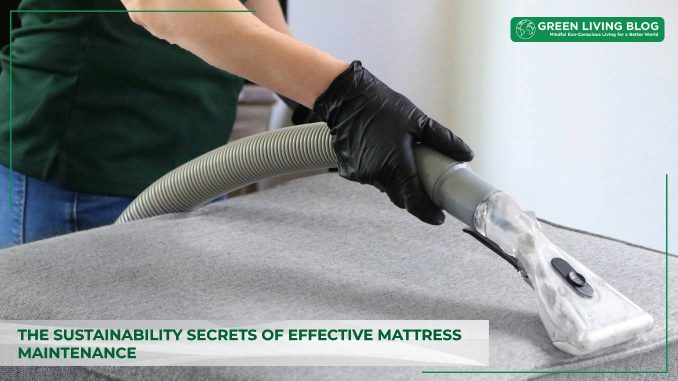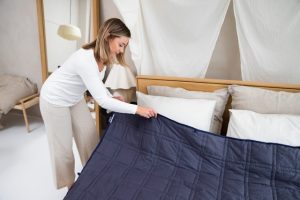
When it comes to maintaining a healthy and sustainable living environment, an often overlooked area is the mattress.
Despite spending roughly a third of our lives in bed, many of us neglect to regularly clean and look after our mattresses.
Unveiled here are the secrets to efficiently and effectively purging your mattress from all the unwanted bacteria, allergens, and dust mites.
Are you ready to step up your mattress maintenance game?
Why Regular Mattress Cleaning is Vital for Maintenance
Your mattress can be a haven for dirt and allergens, affecting your sleep and overall health. According to Asthma + Lung UK, dust mites are a common cause of allergies and asthma. Hence regular cleaning is more than just freshness.
As you sleep, your body sheds skin cells which provide a feast for invisible pests: dust mites. Droppings from these critters have proven to be irritant substances triggering reactions in people with allergy sensitivities. Your health could be at stake!
Apart from dust mites, let’s not forget body sweat and oils. Over time, this moist condition creates an ideal breeding ground for bacteria and mold. By routinely cleaning your mattress, you’re intervening in this unwanted biological party.
Furthermore, regular cleanliness also extends your mattress lifespan by preventing odors and discoloration derived from accumulated sweat and oil, meaning you spend less on replacement mattresses and reduce waste at the same time.
Common Mattress Cleaning Mistakes
Nobody wants an unclean mattress but some cleaning procedures may unintentionally cause long-term damage to your bedding space. Not thoroughly drying your mattress after steam cleaning creates overly moist conditions that favor mold growth.
Avoid soaking with cleaning products as most mattresses aren’t designed to get excessively wet. Spot-cleaning stains should be done strategically; using minimal moisture and a white cloth prevents color transfer onto the mattress.
Skipping vacuuming is another common mistake. This initial cleaning step eliminates a significant amount of debris, allergens, and dust mites. By not vacuuming first, the dampness from liquid cleaners could bind the dust, making it harder to shift.
For more professional advice on mattress cleaning, make sure to refer to The Happy House Cleaning. Their tips and tricks are a game changer.
1. Effective Mattress Vacuuming Techniques

Effective vacuuming predominantly requires two key elements: a good vacuum cleaner and the right technique. Start by stripping all bedding, then slowly hover your vacuum cleaner nozzle over the surface. Doing so extracts deep-seated dirt and allergens with increased efficiency.
An upholstery attachment on your vacuum assures gentle, yet efficient suction perfect for mattresses. Circular patterns with overlapping strokes ensure that no area is missed. Remember, patience during cleaning often reaps the most rewards.
Focus intensively on seams or crevices as these are hot spots for encrusted grime and dust mites. However, gentle care must be taken not to fray stitching or fabric.
Lastly, flip your mattress over after several cleaning rounds. Bugs and allergens aren’t just on the visible side – they’re likely nesting on the underside too!
2. Removing Stains from Your Mattress
The variety of mattress stains out there is as broad as their causes – urine, blood, sweat or coffee spillages! The secret weapon here lies in your pantry – it’s baking soda and white vinegar!
Mixing white vinegar with lukewarm water creates a powerful agent able to neutralize most stains. Apply sparing amounts using a white cloth; always blot, never rub! Blotting minimizes the risk of pushing the stain further into the mattress fabric.
Blood and tough stains on the other hand, call for a baking soda paste. Apply gently, let it sit, then lightly scrub before vacuuming away the dry residue. However, never soak your mattress entirely with any liquid solutions!
For stubborn stains or older mattresses with heavily ingrained marks, professional mattress cleaners are your best bet. They possess deep-cleaning technologies and industry-specific knowledge on treating various stains safely.
3. Proper Mattress Deodorization Methods

Odor control may seem challenging but fear not! A household favorite, baking soda, doubles up as an odor neutralizer. Sprinkle an abundant amount across your mattress and let it sit for at least 24 hours – it works wonders in absorbing odors.
The use of essential oils provides secondary benefits by imbuing your mattress with calming or refreshing scents. Eucalyptus, tea tree or lavender oils are great choices due to their antimicrobial properties.
Mix a few drops into baking soda; sift evenly across your mattress surface and vacuum it off after a day. Remember that although essential oils smell amazing, they’re potent – thus only small amounts are needed!
Adequate ventilation also plays a significant role in odor control. Allow your mattress to breathe by removing bed linens completely once a week. Regularly airing your bedroom aids in moisture control hence inhibiting musty odors from forming.
4. How to Dry a Mattress Correctly
Proper drying of a mattress is as important as its cleaning. After spot cleaning your mattress, it’s crucial to let it air dry completely. Drying can be facilitated by running a fan nearby or opening the windows to circulate fresh air across the damp spot.
The Sleep Foundation emphasizes that moisture can deepen discolorations and foster an unfavorable environment for bacteria growth. Therefore, skipping on efficient drying methods may risk mold or mildew infestation in your bed.
In situations where patience outwears the drying period, heated appliances like hair dryers might be beneficial. However, they must be employed wisely – too much heat can cause internal damage. Always maintain a safe distance between your hairdryer and the mattress.
Protective covering using waterproof mattress protectors discourages moisture penetration thus reducing drying time after cleaning. Utilizing these coverings offers dual benefits – not only preventing stains from seeping into your mattress but also protecting against mite incursion.
5. Benefits of Professional Mattress Cleaning

Embarking on a do-it-yourself (DIY) mattress cleaning routine can indeed save costs but there are undeniable perks of professional cleaning services as well. Professionals utilize high-grade equipment, like industrial dust extractors and anti-allergenic treatments, to ensure thorough clean up.
Professionals use health-friendly detergents suited for people with sensitised skins or history of dermatological allergies.
Professional cleaners also have expert efficiency in removing entrenched stains. They apply a range of stain pre-treatments based on the stain’s cause, character and age – ensuring effective and safe removal without material damage.
Lastly, hiring professional cleaners saves you time and effort, making it a viable option for those with rigorous work schedules or physical constraints. Remember, your mattress deserves a well-rounded cleanse to provide you a sound sleep!
6. Natural Mattress Cleaning Solutions
Harsh chemical-filled cleaning agents may seem quintessential for stubborn mattresses stains but natural solutions could be an equally potent alternative. This choice not only is environment-friendly but also ensures safety for sensitive skins.
The University of Georgia’s Indoor Air Quality team stresses the effectiveness of hydrogen peroxide as a safer bleach alternative. Apply this mildly onto your mattress after mixing it with water for dealing with tough stains.
Lemon juice mixed with salt can help tackle light discolorations while being mild on fabric. Allow this mixture on the stain for an hour followed by wiping off using a damp cloth.
Borax powder holds excellent antibacterial properties which when sprinkled lightly and left for a few hours before vacuuming can revitalize your mattress providing an antiseptic cleanse.
For pet owners, natural enzyme cleaners are efficient in breaking down the proteins found in pet urine, leaving your mattress fresher than ever. Nevertheless, always patch test a new cleaning solution before widespread use!
7. Maintaining a Clean Mattress

Maintaining a clean mattress goes beyond scheduled cleanings. This routine involves changing bed linens regularly to curb dust mite growth and using mattress covers to safeguard against unwanted spills or allergens.
According to the American College of Allergy, Asthma and Immunology, encasing your mattress with allergen-proof covers can significantly minimize mite population, thus it’s a must-try for allergy sufferers.
Maintaining appropriate room temperature restricts moisture buildup. Research suggests keeping the thermostat at around 60 to 67 degrees Fahrenheit during sleep for optimal comfort and hygiene.
Flipping and rotating your mattress regularly balances out wear and tear, ensuring you get most out of its lifespan. This practice also helps in the even distribution of weight hence preventing uncomfortable indentations or lumps on your sleeping surface.
8. Dealing with Specific Mattress Problems
Your problem-solving tactics should differ based on specific issues you’re dealing with. Unpleasant odors call for baking soda applications while sunlight exposure can act as a natural disinfectant against bacteria and mites.
In the case of bed bugs, which are a major issue according to a report by the United States Environmental Protection Agency, professional services are advisable since DIY methods rarely eradicate them completely.
Persistent allergic reactions may hint at heavy dust mite infestation. Here, apart from regular vacuuming, hypoallergenic covers lend a supporting hand in reducing allergen exposure.
Mildew odor or visible mold patches need immediate attention. Start by thoroughly drying your mattress; mix rubbing alcohol with warm water and lightly dab onto affected areas followed by complete drying. For severe cases seek professional cleaning strategy!
Final Thoughts
An effective mattress cleaning routine is more than just sprinkling baking soda and vacuuming – it necessitates regular effort, correct cleaning strategies, and the ability to deal with the specific problems your mattress may host.
Embrace these cleaning methods and reward yourself with a healthier living space. Remember, investing your time in the right cleaning regimen equates to investing in good quality sleep and ultimately better health.
![]()
Author Profile

- Eco Warrior by day, Eco Blogger by night trying to get the eco balance right.
Latest entries
 EnvironmentJuly 14, 20257 Smart and Sustainable Home Upgrades for 2025
EnvironmentJuly 14, 20257 Smart and Sustainable Home Upgrades for 2025 EnvironmentJuly 9, 2025Does Double Glazing Help Increase Your EPC Rating?
EnvironmentJuly 9, 2025Does Double Glazing Help Increase Your EPC Rating? Green LivingJune 30, 2025Herbal Tea for Insomnia: Your Guide to Natural, Sustainable Sleep Solutions
Green LivingJune 30, 2025Herbal Tea for Insomnia: Your Guide to Natural, Sustainable Sleep Solutions EnvironmentJune 24, 2025What are the most energy-efficient Home Upgrades in 2025?
EnvironmentJune 24, 2025What are the most energy-efficient Home Upgrades in 2025?





Leave a Reply
You must be logged in to post a comment.